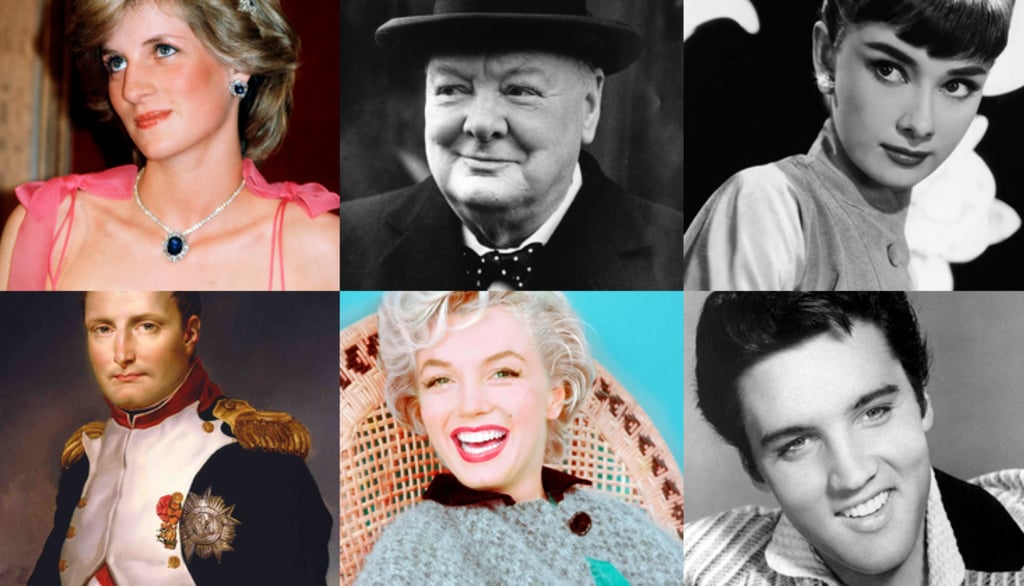Famous People and Their Signature Scents
What Marilyn Monroe wore to bed. Why Napoleon loved cologne. A historical and pop culture roundup of iconic figures and their fragrance obsessions.
THE SCENT DAILY
7/18/20257 min read


Fragrance is an invisible autobiography. Long before a word is spoken or a hand is shaken, scent delivers a quiet prologue that tells others where we have been, how we see ourselves, and sometimes how we want people to remember us. Perfume houses understand this intimate storytelling power, but so too did the icons who wielded fragrance as another instrument of influence. The olfactory preferences of a handful of famous figures, whether it be a Hollywood ingénue or a continent‑shaping emperor, can tell us how scent can distill personality, cultural mood, and even political strategy into just a few concentrated drops.
Marilyn Monroe: Chanel No. 5 and the Art of Suggestion
In 1952, a young reporter from LIFE magazine asked twenty‑six‑year‑old Marilyn Monroe what she wore to bed. Her answer, “Only a few drops of Chanel No. 5,” was both spontaneous and meticulously strategic. At the time Monroe was still crafting her public mystique. By binding herself to Ernest Beaux’s 1921 aldehydic bouquet, which was already famous then yet still slightly avant‑garde, she gained a fragrant shorthand for modern femininity: clean, luminous, and undeniably sensual.
The perfume’s abstract structure, dominated by jasmine, ylang‑ylang, and synthetic aldehydes, stood in stark contrast to the single‑flower soliflores popular with Monroe’s contemporaries. Post‑war American women were beginning to balance domestic expectations with new professional ambitions. No. 5’s complex layers mirrored that duality, and Monroe sensed it. Her endorsement gave everyday women permission to adopt a bold, cosmopolitan identity.
Friends recalled that she kept the bottle on her nightstand and applied it not only before events but also on quiet studio‑apartment evenings, misting a cloud over her sheets. That practice really shows how fragrance is actually self‑care rather than mere adornment. The press amplified her comment, but it was in private that its truth resonated.
Chanel claims a bottle of No. 5 sells every thirty seconds. While advertising budgets help, Monroe’s off‑the‑cuff remark forged an emotional link between scent and intimate confidence that money alone could never replicate. Today, No. 5 remains the bestselling perfume of all time, and Monroe’s quip is still quoted in marketing seminars as the perfect earned‑media coup.
Napoleon Bonaparte: Eau de Cologne as Field Strategy
Napoleon was not merely fond of scent; he literally treated it like armor. Contemporary records suggest he consumed two quarts of Jean‑Marie Farina’s original Eau de Cologne every month, even drinking some for its supposed medicinal benefits and dousing letters, gloves, and even uniforms with the rest. Yes, you could say he was a little obsessed. And even that is an understatement.
Farina’s 1709 formula blended Calabrian bergamot, Sicilian lemon, petitgrain, rosemary, and neroli. Its brightness cut through the era’s unsanitary battlefields and damp palaces by offering a portable Mediterranean sunrise. With campaigns stretching from Egypt to Russia, Napoleon craved an olfactory anchor that recalled the optimism of the Côte d’Azur.
The emperor believed a crisp citrus aura projected discipline and vitality to troops who often marched on half rations. Letters reveal he sometimes ordered fresh supplies of cologne before ammunition, trusting morale would translate to military efficacy. When Josep Ina—his first wife—refused heavy doses of the fragrance, he teased that she lacked strategic imagination. This is interesting, as it shows that Napoleon viewed fragrance as a strategic choice.
After his exile, Farina’s cologne went mainstream across Europe. Royals copied Napoleon’s habit of soaking sugar cubes in the elixir as a digestif. Even today, the expression “to take one’s Waterloo” survives in perfumery slang to describe a scent that outlives its creator, which attest to Napoleon’s reluctant role as Eau de Cologne’s most effective salesman.
Audrey Hepburn: L’Interdit and the Birth of Celebrity Licensing
Hubert de Givenchy created L’Interdit in 1957 exclusively for Audrey Hepburn. The name—French for “forbidden”—was playful: Hepburn initially banned the couturier from releasing the scent commercially, wanting it as her private signature. The fragrance combined rose, jasmine, violet, and a whisper of clove over a sandalwood base, echoing Hepburn’s on‑screen blend of innocence and sophistication.
When Hepburn finally relented in 1960, L’Interdit became one of the earliest examples of celebrity‑driven perfume marketing. Unlike modern licensing deals, she took no royalty. Yet the commercial launch set a template later exploited by every starlet with a scent contract.
Costume designers say Hepburn sprayed wrists and silk scarves before fittings because she believed fragrance completed a silhouette. That holistic view influenced Givenchy’s fashion house, inspiring fabric finishes designed to hold scent longer—a practice some luxury ateliers still research.
In 2018 Givenchy re‑issued L’Interdit in a contemporary formula starring vetiver and patchouli. Reviews note it feels bolder, mirroring the changing notions of femininity. Still, vintage collectors cherish decants of the original for its powdery aldehydes—an olfactory snapshot of Roman Holiday–era glamour.
Winston Churchill: Creed Tabarome and the Politics of Aroma
Photographs immortalize Churchill with a Romeo y Julieta cigar, but fewer people know he commissioned a bespoke fragrance from the House of Creed in the 1930s. Tabarome Millésime marries tobacco leaf with ginger, sandalwood, and green tea, notes that evoke club chairs, polished dispatch boxes, and midnight war rooms.
Creed perfumers sourced tobacco absolute from Sumatra for its earthy nuance, avoiding the ashy quality of burnt leaf. The result smells of cured cigar boxes, not smoke—a crucial distinction for a leader who needed gravitas without smelling like yesterday’s battle fatigue.
During wartime visits to Roosevelt and Stalin, Churchill’s scent acted as an olfactory calling card. British aides noted that foreign secretaries could detect his approach in corridors before they heard his cane. In an age before hyper‑security, such sensory advance notice was surprisingly useful for hurried protocol.
Creed revived Tabarome in 2000, marketing it to entrepreneurs who idolize Churchillian grit. While the modern blend is smoother, collectors pay premiums for pre‑reformulation bottles, insisting they capture the damp leather council rooms of the Blitz era.
Princess Diana: Quelques Fleurs and Empathy Encapsulated
Diana, Princess of Wales, balanced court protocol with unprecedented relatability. Her chosen scent, Quelques Fleurs by Houbigant (1912), mirrored that duality. The fragrance layers more than fifteen florals—rose, tuberose, jasmine, lily‑of‑the‑valley—over civet‑tinged oakmoss, achieving both aristocratic polish and approachable warmth.
Stephan Vaneck, Diana’s makeup artist, recalled that she accidentally spilled half a bottle of Quelques Fleurs down the front of her David Emanuel gown minutes before walking down the aisle in 1981. Rather than panic, she covered the darkened patch with her bouquet and quipped that at least everyone would remember she smelled good.
When visiting AIDS wards and land‑mine zones, Diana wore only a light dab, cognizant that strong fragrances can overwhelm patients. Nurses later reported the faint floral trail delivered comfort, not intrusion. I guess you could say that in some way, perfume also became part of her empathy toolkit.
After her passing in 1997, sales of Quelques Fleurs spiked 30 percent. Unlike fast‑fashion celebrity scents, this century‑old formula gained renewed relevance. Perhaps it is the case that when a fragrance aligns with a life as authentically lived as Diana’s, its power doesn't diminish with time; it only becomes more valuable.
Elvis Presley: Brut, Lenel, and the Scent of Rebellion
Elvis’s stage presence fused Southern gentility with raw energy, a dichotomy mirrored in his grooming habits. Graceland archives list two favorite colognes: Fabergé Brut (1964) and Lenel For Men (1950). Brut opens with bright lemon‑lavender and dries down to vanilla‑tonka, projecting accessible masculinity. Lenel, spicier with carnation and cinnamon, brings to the table that exotic confidence.
Bandmates recounted that Elvis applied cologne after every set, believing fans deserved a performer who smelled as good as he sounded. Road‑crew vans stored backup bottles so he could refresh en‑route to encore performances.
In the 1968 Comeback Special, a Brut bottle allegedly sat off‑camera, visible only to VIP attendees. Within weeks Brut’s U.S. sales surged, proving that word‑of‑mouth could rival advertising budgets when the King approved a product. Today, Brut headlines nostalgia gift sets, but niche collectors scour auction sites for Lenel, long discontinued. Those amber bottles, with Art Deco lines, encapsulate a pre‑Beatles era when a single scent could summarize American optimism.
Grace Kelly: Fleurissimo and the Scent of Sovereign Simplicity
For Grace Kelly, fragrance bridged Hollywood glamour and Monégasque duty. In 1956, Creed crafted Fleurissimo as her wedding gift. The brief: evoke a bridal bouquet suitable for a civil ceremony and a cathedral coronation. The final recipe blended Bulgarian rose, Florence iris, violet, and Moroccan tuberose.
Kelly’s televised wedding required a scent that wouldn’t clash with tightly packed lilies and gardenias decorating Monaco’s Saint Nicholas Cathedral. Creed perfumers adjusted the tuberose ratio to prevent olfactory fatigue among guests seated for hours.
Post‑marriage, Kelly’s public schedule shifted from film sets to hospital openings. Fleurissimo’s dignified sillage proved versatile, discreet enough for charity wards yet distinctive at diplomatic galas. Current brides choose Fleurissimo for its fairy‑tale origin story, not merely its notes. Wedding planners report that when clients request “the Grace Kelly perfume,” they seek more than aroma. They crave the balance of independence and duty that the princess symbolized.
The Silent Language of Scent
Across eras and continents, perfume served these icons as more than decoration. It was armor for Napoleon, empathy for Diana, mise‑en‑scène for Monroe, and brand equity for Hepburn. Their selections show that choosing a fragrance is an act of identity, one that compresses values, ambitions, and vulnerabilities into a molecule‑sized message.
For readers contemplating their own signature scent, the lesson is clear: pick a fragrance that narrates your story when you are silent, and one you will still recognize when history replays your greatest hits. As these seven figures demonstrate, the right perfume will outlast fashion cycles, market crashes, and even empires.
Controlling how you smell is the first step in controlling how people view you. Having one of the five senses in your support when meeting anyone is a sure way to form a good impression. In fact, what you smell like might say more about you than what you wear or even what you say.


